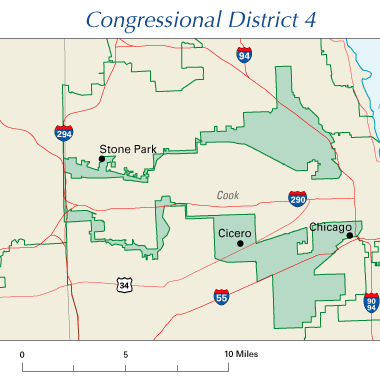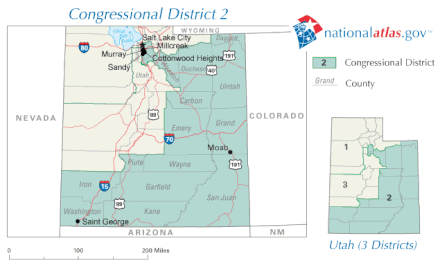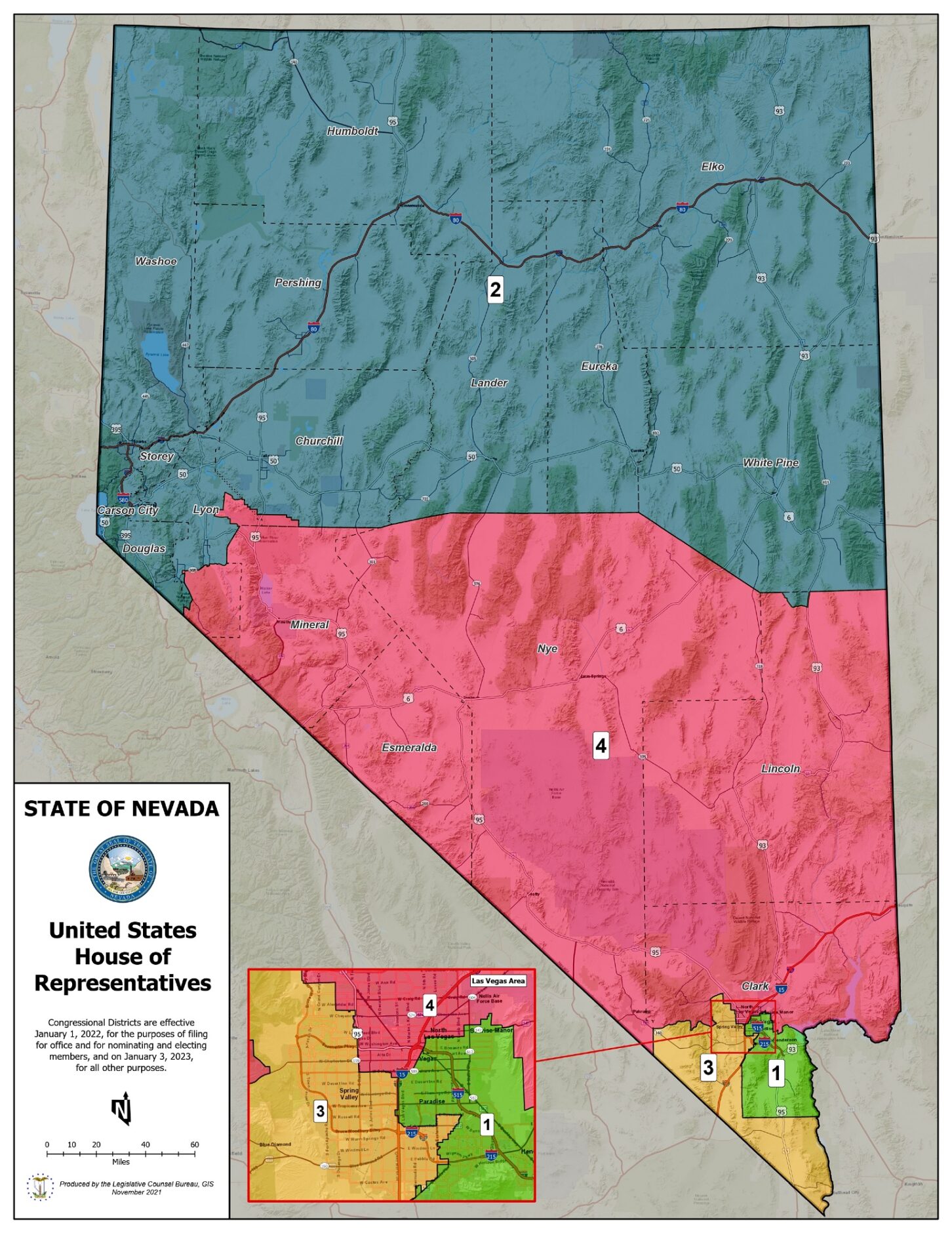RENO, Nev. (CN) — Democrats in Nevada are facing claims of gerrymandering from the left, right and center after redistricting the Legislature and its four Congressional seats.
A contentious and consequential special legislative session ended Nov. 16 with the passage of
Senate Bill 1, finalizing the Silver State’s district maps for the next decade. Every Republican and one Democrat voted no, and the GOP decried the bill as a Democratic power grab. Of the 15 states where the 2020 presidential
election fell within a 10-point margin, Nevada is the only one where Democrats have the governorship, majorities in the Legislature and complete redistricting control.
“What’s hurting Democrats is they’re trying to say because there are fewer blue states gerrymandering, ‘We don’t gerrymander, it’s just the
Republicans,’” said
Sondra Cosgrove, executive director of Vote Nevada and history professor at College of Southern Nevada. “We are gerrymandering just as bad. It’s just easy not to pay attention to us because you’ve got
Texas,
North Carolina and
Ohio, which are huge gerrymandering cases.”
Adam Podowitz-Thomas, senior legal analyst from the
Princeton Gerrymandering Project, said there was a “good possibility” that gerrymandering suits could be filed in all 50 states.
“This is going to be perhaps the most highly litigated redistricting cycle we’ve ever seen,” Podowitz-Thomas said. “It’s going to be a lot on the courts and judges to figure out.”
On Nov. 17, two Republicans from sprawling Nye County
sued claiming partisan gerrymandering violates the state’s
voter bill of rights. The Republican plaintiffs, Assemblyman Gregory Hafen and former county commissioner John Koenig, claim the districts were designed to weaken rural voters’ influence outside the
more populous Clark and Washoe counties. The new map splits Pahrump, the conservative Nye County seat, and divides the ruby-red county into three different Assembly districts.
“I think the case that’s being made is strong,” said Doug Goodman, director of
Nevadans for Election Reform. “[The Legislature] definitely split communities of interest by depriving the rural residents of Nye County a chance of having somebody elected and represent them in the Legislature. No question, [the maps] are partisan gerrymanders.”
Requests for comment sent to the plaintiffs in the lawsuit and multiple members of the Legislature went unanswered. But Goodman voiced concern about the Legislature’s largely unfettered control over redistricting, saying it allows their power and influence to expand and disregards Nevada’s growing nonpartisan voting bloc.
According the
Princeton Gerrymandering Project and
FiveThirtyEight, Nevada’s new congressional map has one Republican-leaning seat and three that lean slightly Democratic which are currently held by Democrats. A once solid-blue district was divided, ostensibly to shore up support for the Democrats facing tough reelection fights in 2022.
Podowitz-Thomas explained Nevada’s maps aren’t “durable” like many partisan gerrymanders are.
“The Democratic Party gave itself such small majorities in the three districts they’re going to control that it’s a risky proposition for them over the next decade,” Podowitz-Thomas said, noting all four congressional seats could feasibly go to Republicans during a strong GOP election.
Several Latino groups from Clark County’s liberal core fiercely opposed the maps.
Cosgrove said her predominantly working-class, Latino neighborhood in east Las Vegas is rife with frustration. She said their new congressional district will no longer have a racially diverse, working-class electorate of the “same socioeconomic strata.” Instead, the Democrats “blew up their base,” splintering the once solid-blue district and adding many white, wealthier communities.
“If I was a Democrat, I would be secretly praying the court came in and overturned [the maps],” Cosgrove said, noting the anger within communities of color regarding redistricting. “If these maps stay, [Democrats] could face losing just because people are mad at them and don’t show up.”
Cosgrove said the Legislature's reduction of the Latino population from about 46% to 32% in the district split voters with similar working-class interests and ignored their requests to be packed together to choose candidates who represent those collective interests.
Nevadans Count, a coalition of organizations advocating for fair redistricting, also lobbied against fragmenting the predominantly Latino congressional district and proposed alternative maps.
“It puts pretty different income levels in the same district,” Noé Orosco, spokesperson for
Silver State Voices and Nevadans Count, said of the cities now grouped into the same district. “With those cities, whenever they are asking or advocating for some funding, they could potentially be putting each other at odds.”
Orosco said the final maps were “not the result we were hoping for.” He said the coalition was “monitoring any anything related to redistricting in the state of Nevada,” including the ongoing legal battles, but had not decided whether to bring a racial gerrymandering suit. Orosco was unaware of any Latino groups within the coalition being approached to join the Republicans’ lawsuit.
Cosgrove said the Democrat-controlled Legislature had also tried to split the solid blue district between the wealthier, white suburban districts during 2011’s redistricting. Those maps were twice vetoed by then-Governor Brian Sandoval, a Republican and former federal judge.
With no maps, Judge James Russell appointed special masters to redraw the maps utilizing public feedback. Cosgrove noted Russell is now the judge assigned to the Nye County Republicans’ suit. She expects a similar outcome given how similar the Legislature’s maps are now to the ones rejected a decade ago.
Podowitz-Thomas said “intrinsically, the map-drawing process is one of trade-offs,” but a necessary aspect of drawing fair maps “is that communities have the opportunity to have feedback on the map and that feedback was taken seriously.”
The Legislature did, however incorporate feedback from the Indigenous community. Tammi Tiger, civic engagement program consultant with the Las Vegas Indian Center, testified against proposals dividing some tribal lands and reservations into different districts. When the revised maps kept the Indigenous communities intact, Tiger said the tribes and tribal citizens were “very excited and appreciative.”
“For Indigenous people, the people and the land are synonymous. The land is sacred to us,” Tiger said. “It’s still important that any decisions that are made to tribal lands, we have one elected representative to go to.”
Tiger and Orosco both said a public meeting regarding redistricting should be held on every tribal land to set a precedent honoring the government-to-government relationship with tribes.
“A lot of our tribes are rural,” Tiger explained. “They’re not going to drive two hours when they’ve got kids to take care of and obligations to meet, so being able to host those on tribal lands would be much more effective at [getting] their input.”
Governor Steve Sisolak praised the Legislature’s consideration of public feedback in a
statement issued after he signed the maps into law.
“These maps reflect Nevada’s diversity and reflect public feedback gathered throughout the legislative process,” said Sisolak. Cosgrove blasted the response.
“Dude, are you smoking something? No one testified in favor of the maps. When it came time for opposition, it was two hours of people explaining why they hated the maps,” Cosgrove said, noting the dissenters included people of color, rural voters, conservatives and more.
Cosgrove, Goodman and Podowitz-Thomas all agree single-party control of redistricting exacerbates gerrymandering risks. But Cosgrove said Nevada’s “bigger problem” is the Legislature exempting itself from open-meeting laws, muddying the waters of the process.
“If you’ve got a Legislature refusing to tell us who drew the maps, refusing to tell us justifications for why they drew the maps the way they did, there’s absolutely no way to fix this process,” said Cosgrove.
Goodman and Cosgrove advocate for an independent redistricting commission. Last week, Cosgrove
filed an initiative for a 2022 ballot question that could allow voters to strip the redistricting power from the Legislature and place Republicans, Democrats and independents on a commission subject to open-meeting laws and higher redistricting standards.
“I’m not assuming people are going to sing and hold hands and draw a map. You can fight it out all you want, but it just needs to be very transparent,” Cosgrove said. “We just want to be there while you’re doing it and have a say.”
Podowitz-Thomas said court-mandated maps and independent commissions are generally much fairer than legislators. But he warned commissions staffed by many politicians can still gerrymander.
“In Ohio, they drew a map and it was a partisan gerrymander. In
Virginia, where half the commission was made up of politicians, they failed to draw a map at all and it went to the state Supreme Court to hire special masters,” Podowitz-Thomas said.
But Goodman and Cosgrove voiced confidence that redistricting reforms have the popular support in Nevada and elsewhere to pass via ballot initiative.
“I think the ‘we the people’ part of the Constitution is going to roar up on its hind legs and take a swat at the political parties,” Cosgrove said.







/cloudfront-us-east-1.images.arcpublishing.com/dmn/SPLJRPEVFZEJ3JG7HUCMVII72U.jpg)

